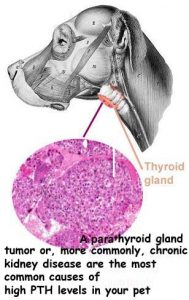Ron Hines DVM PhD
Your Pet’s Parathyroid Gland Hormone Blood Level = PTH
Your pet’s multiple parathyroid glands are located under its neck near its two-lobed thyroid gland. These parathyroid glands are responsible for keeping the calcium level in your cat or dog’s bones and in its blood at optimal levels. (read here)
The parathyroid glands do so by constantly monitoring the blood calcium levels in your dog or cat and secreting a hormone, PTH when those levels become too low. PTH causes your pet’s kidneys to conserve calcium, by lowering the amount lost in its urine while, at the same time, increasing the amount of phosphate purged from the body in urine.
PTH also encourages its kidneys to produce the active form of vitamin D (calcitriol) to enhance calcium absorption from your pet’s food. At the same time PTH causes certain bone cells (osteoclasts) to release bone calcium into the pet’s blood stream.
It is not possible to make any decisions regarding PTH levels and the status of your cat or dog’s parathyroid glands without simultaneously knowing the pet’s blood calcium and phosphorus levels.
Reasons Why Your Cat or Dog’s PTH Levels Could Be High:
Renal secondary hyperparathyroidism. This is the most common form of parathyroid gland disease or over-activity.
It occurs when your dog or cat’s kidneys are failing and can no longer conserve the calcium that passes through them. In that situation, too much calcium spills out in the pet’s urine. In response to sensing low blood calcium levels, your pet’s parathyroid glands increase their production of PTH. It is to no avail, however, because the kidneys no longer have the capacity to react to the PTH. What unfortunately does occur, however is a weakening of bone throughout the dog or cat’s body (osteomalacia). The condition is more common in dogs than in cats.
Renal secondary hyperparathyroidism can also occur on calcium or vitamin D3-deficient diets. It can also occur in cases of starvation or malnutrition.
Over active parathyroid glands (primary hyperparathyroidism) will also cause high PTH levels. The usual cause for over-active parathyroid glands are one or more benign tumors within the gland(s) (adenomas). Blood calcium levels will also increase when this problem is present.
A normal PTH level in a pet whose blood calcium levels are high (and therefore should not be producing much PTH) is also suggestive of hyperparathyroidism.
PTH levels can be falsely elevated whenever health issues decrease blood flow through your pet’s kidneys (reduced glomerular filtration rate = GFR) as occurs in congestive heart failure.
Reasons Your Dog or Cat’s PTH Levels Might Be Low:
This condition is quite rare in dogs or cats. When it does occur, it is almost always due to neck surgery in which the parathyroid glands were accidentally removed. Generally, that surgery involved the thyroid gland, but it could have involved the larynx or, perhaps removal of cancerous lymph nodes or other neck tumors.
In humans, low magnesium and autoimmune parathyroid gland destruction have been reported. I know of no similar cases reported in dogs or cats.
Complementary Tests:
CBC/ WBC and blood chemistry Panel including blood calcium level and phosphate level, urinalysis, evaluation of the calcium content and vitamin D3 availability in the pet’s diet, perhaps a PTHrP assay for evidence of lymphoma if blood calcium levels are high
DxMe
